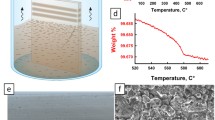Abstract
Three kinds of texture-reinforced oxide ceramic laminates with strongly bonded interfaces have been fabricated. All three were based on highly textured α-alumina interlayers, but each with a different oxide laminate matrix and a correspondingly different thermal mismatch between the textured interlayers and the matrix. Alginate-based, aqueous gel casting was used to produce a flexible tape for all the compositions studied. The highly textured alumina (TA) interlayers were derived from gel-cast tapes containing aligned alumina seed platelets. It has been found that the strongest texture derived from 9.1 vol% of the seed platelets in the gelled precursor tape. Using the March–Dollase model for texture analysis, the oriented volume fraction in the highly textured interlayers was estimated to vary from 60 to 80%.












Similar content being viewed by others
References
Paulik SW, Faber KT, Fuller ER (1994) J Am Ceram Soc 77:454
Carisey T, Laugier-Werth A, Brandon DG (1995) J Euro Ceram Soc 15:1
Vedula VR, Glass SJ, Saylor DM, Rohrer GS, Carter WC, Langer SA, Fuller ER (2001) J Am Ceram Soc 84:2947
Ma Y, Kruger KL, Bowman KJ (1991) J Am Ceram Soc 74:2941
Lee F, Sandlin MS, Bowman KJ (1993) J Am Ceram Soc 76:1793
Pentecost JL, Wright CH (1963) Adv X-Ray Anal 7:174
Zimmerman MH, Faber KT, Fuller ER (1997) J Am Ceram Soc 80:2725
Baskin DM, Zimmerman MH, Faber KT, Fuller ER (1997) J Am Ceram Soc 80:2929
Hirao K, Nakaoka T, Brito ME, Kanzaki S (1994) J Am Ceram Soc 77:1857
Hong SH, Cermignani W, Messing GL (1996) J Euro Ceram Soc 16:133
Sacks MJ, Scheiffele GW, Staab GA (1996) J Am Ceram Soc 79:1611
Seabaugh MM, Kerscht IH, Messing GL (1997) J Am Ceram Soc 80:1181
Suvaci E, OH KS, Messing GL (2001) Acta Mater 49:2075
Clegg WJ, Kendall K, Alford NM, Button TW, Birchall JD (1990) Nature 347:455
Davis JB, Kristoffersson A, Carlström E, Clegg WJ (2000) J Am Ceram Soc 83:2369
Gee IA, Dobedoe RS, Vann R, Lewis MH, Blugan G, Kuebler J (2005) Adv Appl Ceramics 104(3):103
Cai PZ, Green DJ, Messing GL (1998) J Eur Ceram Soc 5:2025
Rao MP, Sánchez-Herencia AJ, Beltz GE, McMeeking RM, Lange FF (1999) Science 286:102
Hatton B, Nicholson PS (2001) J Am Ceram Soc 84:571
Claussen N, Le T, Wu S (1989) J Euro Ceram Soc 5:29
Claussen N, Travitzky NA, Wu S (1990) Ceram Eng Sci Proc 11:806
Wu S, Holz D, Claussen N (1993) J Am Ceram Soc 76:970
Claussen N, Wu S, Holz D (1994) J Euro Ceram Soc 14:97
Boch P, Giry JP (1985) Mater Sci Eng 71:39
Harris GB (1952) Philos Mag 43:113
Barrett CS, Massalski TB (1978) Structure of metals, crystallographic methods, principles and data, 3rd ed. Permagon Press, New York
Valvoda V, Järvinen M (1990) Powder Diffraction 5:200
Dollase WA (1986) J Appl Cryst 19:267
Cline JP, Vaudin MD, Blendell JE, Handwerker CA, Jiggetts R, Bowman KJ, Medendorp N (1994) Adv X-Ray Anal 37:473
Roeder RK, Trumble KP, Bowman KJ (1997) J Am Ceram Soc 80:27
Acknowledgements
This work was supported by AFIRST (French-Israel Association for Scientific and Technological Research) under contract #6052194. The authors would like to acknowledge the previous work of Thierry Carisey who pioneered the concept of texture control in tape-cast alumina while supported by the Government of France as a CSN at Technion. The authors would also like to thank Dr. Suxing Wu for his unstinting help in developing RBAO and RBM processing for laminated systems.
Author information
Authors and Affiliations
Corresponding author
Rights and permissions
About this article
Cite this article
Wei, M., Zhi, D. & Brandon, D.G. Oxide ceramic laminates with highly textured α-alumina interlayers: I. Texture control and laminate formation. J Mater Sci 41, 7425–7436 (2006). https://doi.org/10.1007/s10853-006-0808-y
Received:
Accepted:
Published:
Issue Date:
DOI: https://doi.org/10.1007/s10853-006-0808-y




